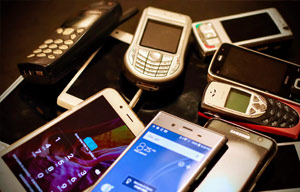Regulasi Alat Telekomunikasi di Afrika Selatan
- Regulasi telekomunikasi di Afrika Selatan adalah bidang yang sangat kompleks dan diserahkan kepada mereka yang melakukannya telah mengadopsinya sebagai spesialisasi.
- Khususnya, kesadaran akan hak atau kewajiban konsumen dan pemahaman tentang kerangka peraturan untuk interkoneksi dan penyewaan fasilitas akan sangat penting dalam menegosiasikan perjanjian dan tingkat layanan untuk penyediaan layanan komunikasi elektronik.
- Undang-undang utama Parlemen yang mengatur industri komunikasi elektronik di Afrika Selatan adalah Electronic Communications Act 36 tahun 2005 (“the ECA”), yang telah menggantikan Undang-Undang Telekomunikasi pada tahun 1996 ("Undang-Undang Telekomunikasi") pada 19 Juli 2006. ECA dapat dikategorikan sebagai pro kompetitif undang-undang yang sangat kontras dengan Undang-Undang Telekomunikasi, yang proteksionis dalam upaya melindungi penyedia sambungan telepon tidak bergerak/telepon rumah, Telkom SA Ltd, dari pengaruh persaingan global.
ECA (Electronic Communications Act) mengatur berbagai jenis masalah, termasuk:
- lisensi,
- akses,
- hak infrastruktur,
- manajemen dan penugasan frekuensi,
- pasar dan persaingan usaha,
- layanan universal.
ECA adalah undang-undang yang mengatur antara penyiaran dan telekomunikasi khususnya di wilayah Afrika Selatan.
Undang-undang lain yang berdampak pada sektor ini meliputi:
- Peraturan Intersepsi Komunikasi dan Ketentuan terkait Komunikasi
- Undang-Undang Informasi 70 tahun 2002 (“RICA”);
- Undang-Undang Persaingan 89 tahun 1998 (“Undang-Undang Persaingan”);
- Undang-Undang Film dan Publikasi 65 tahun 1996 (“UU Film dan Publikasi”);
- UU ICASA 13 tahun 2000 (“UU ICASA”);
- UU Penyiaran 4 tahun 1999 (“UU Penyiaran”);
- Undang-Undang Komunikasi dan Transaksi Elektronik 25 tahun 2002 (“UU ECT”).
Links:
- ECA
- RICA
- Film & Publications Act
- Broadcasting Act
- ECT Act
- Protection of Personal Information Bill.
Departemen Komunikasi (DoC) bertanggung jawab untuk menetapkan kebijakan komunikasi elektronik, mengawasi spektrum frekuensi radio dan mewakili Afrika Selatan dalam forum internasional seperti International Telecommunications Union (ITU).
Otoritas Komunikasi Independen Afrika Selatan
Otoritas Komunikasi Independen Afrika Selatan (ICASA) adalah komunikasi independen regulator, dibentuk dan diatur oleh UU ICASA. Pembentukan regulator independen adalah konsekuensi keanggotaan Afrika Selatan dari Organisasi Perdagangan Dunia (WTO)
Perizinan Komunikasi Elektronik
Registrasi dan pemberian lisensi komunikasi elektronik di Afrika Selatan dilakukan oleh ICASA di bawah Electronic Communications Act of 2005.
Mengapa ada persyaratan lisensi?
Pemerintah memberlakukan persyaratan lisensi untuk memastikan bahwa:
- Sumber daya yang langka seperti frekuensi dan angka dapat dialokasikan dan dikoordinasikan secara efisien
- Layanan disediakan di daerah yang kurang terlayani dan pedesaan
- Mereka memiliki wewenang atas lisensi untuk keperluan mengatur pasar dan persaingan, Konsumen dilindungi dalam berurusan dengan penyedia layanan.
Kapan lisensi diperlukan?
Sebagai aturan umum, lisensi diperlukan setiap kali komunikasi dilakukan dari satu titik ke titik lainnya atau di mana layanan komunikasi disediakan melintasi batas-batas publik
Ada dua kategori utama dari lisensi layanan yang tersedia di bawah ECA:
- Lisensi Layanan Jaringan Komunikasi Elektronik (ECNS): lisensi ini mengesahkan pemegang untuk meluncurkan dan mengoperasikan jaringan fisik. Jaringan ini dapat terdiri dari teknologi apa pun Anda memilih: peralatan radio (untuk jaringan nirkabel), kabel tembaga, kabel serat optik dll. ECNS pemegang lisensi juga dapat mengadakan perjanjian komersial dengan pemegang lisensi lain untuk memungkinkan mereka menggunakan jaringan komunikasi elektronik yang dimiliki dan dioperasikan oleh pemegang lisensi ECNS
- Lisensi Layanan Komunikasi Elektronik (ECS): lisensi ini memungkinkan Anda untuk menyediakan layanan kepada pelanggan melalui jaringan Anda sendiri atau orang lain. Ini biasanya akan menjadi lisensi yang dipegang oleh ISP yang tidak mengoperasikan jaringan sendiri atau fasilitas jaringan.
Lisensi berdasarkan Undang-Undang Komunikasi Elektronik 36 tahun 2005
Perlindungan Konsumen
ICASA diamanatkan untuk melakukan peran perlindungan konsumen dan untuk memajukan kepentingan konsumen komunikasi elektronik secara umum. ICASA secara umum tidak efektif dalam peran ini.
Peraturan Kode Etik
Tujuan dari peraturan ini adalah untuk menetapkan standar perilaku yang dapat diterima bagi pemegang lisensi dalam berurusan dengan konsumen & untuk melindungi hak-hak konsumen di pasar komunikasi elektronik.
Peraturan ini berlaku untuk semua ECS dan pemegang lisensi ECNS sejauh mereka berurusan dengan konsumen (yaitu orang perseorangan termasuk pengguna akhir yang menggunakan dan / atau menerima untuk mereka sendiri menggunakan layanan dan / atau produk dari layanan berlisensi).
Kode Etik untuk Penyandang Cacat
Kode Etik ini menetapkan kewajiban pemegang lisensi untuk menyediakan layanan bagi para penyandang cacat.
Pengendalian Harga
Layanan terbaik yang ICASA dapat berikan kepada konsumen adalah mengambil langkah-langkah untuk mengatasi tingginya biaya komunikasi di Afrika Selatan. ICASA mencoba mengkontrol harga eceran sebagai kondisi lisensi pro-kompetitif dalam lisensi pemegang lisensi ditemukan memiliki Kekuatan Pasar Signifikan (SMP). Namun, proses yang harus diikuti sangat berbelit-belit dan ICASA masih belum menyelesaikannya masalah penetapan harga pasar tersebut di Afrika Selatan.
Spektrum Frekuensi Radio
Departemen Komunikasi (DoC) bertanggung jawab untuk berinteraksi dengan ITU (international telecommunication union) dan mewakili Afrika Selatan di Konferensi Komunikasi Radio Dunia yang diadakan oleh ITU setiap empat tahun. Menteri Komunikasi memiliki wewenang tertinggi atas rencana pita yang menetapkan penggunaan berbagai pita frekuensi yang dapat dilakukan oleh pengguna. Afrika Selatan berada di dalam Wilayah 1 ITU dan rencana band sebagian besar akan sesuai dengan yang disepakati di bawah naungan ITU.
Penomoran
ICASA bertanggung jawab atas pengelolaan rencana penomoran nasional dan penerbitan alokasi angka untuk pemegang lisensi. Rencana penomoran saat ini sedang ditinjau dan peraturan penomoran diselesaikan di bawah Undang-Undang Telekomunikasi yang sedang digunakan. Hanya pemegang lisensi IECS yang berhak atas alokasi angka. Hak tersebut mencakup nomor geografis (tetap) dan non-geografis (seluler, VoIP).
PERATURAN PERALATAN KOMUNIKASI ELEKTRONIK AFRIKA SELATAN
Peraturan ini harus diterapkan untuk semua peralatan komunikasi elektronik dan fasilitas, termasuk peralatan radio.
STANDAR KOMPATABILITAS ELEKTROMAGNETIK (EMC)
(1) Dalam hal tidak ada referensi yang dibuat untuk jenis instalasi, atau jika peralatan dapat dipasang di situs Domestik atau Industri, Domestik level harus berlaku;
(2) Saat menguji kepatuhan dengan standar emisi yang relevan, pengujian peralatan harus mematuhi SANS 216 (CISPR 16) sebagaimana ditentukan dalam ini Peraturan Saat menguji kepatuhan dengan kekebalan yang relevan standar, alat uji harus memenuhi standar yang relevan sebagai ditentukan dalam Peraturan ini;
(3) Standar EMC khusus produk akan diutamakan daripada keluarga Produk Standar EMC. Standar produk-keluarga akan diutamakan daripada Generic standar.
APLIKASI PERATURAN INI
(1) Semua peralatan yang mengeluarkan Sertifikat Persetujuan dari ICASA yang valid sebelum diundangkannya Peraturan ini akan dianggap sebagai diterbitkan sesuai dengan Peraturan ini;
(2) Kecuali ditentukan lain dalam Peraturan ini, semua Jenis Persetujuan Sertifikat yang dikeluarkan berdasarkan standar sebelumnya tetap valid;
(3) Dalam hal terdapat inkonsistensi dengan rentang frekuensi sebagai dirinci dalam standar yang berlaku, sejauh itu, frekuensi yang berlaku rencana akan menang.
Standar Kompatibilitas Elektromagnetik (EMC)
Standar EMC ini menentukan kondisi umum, metode pengukuran dan metode dan batasan tes terkait.
|
Classification of Equipment
|
Applicable standard
|
|
Radio disturbance and immunity apparatus - Measuring apparatus
|
SANS 216-1-1
(CISPR 16-1-1 ed3.1)
|
|
Radio disturbance and immunity apparatus - Conducted disturbances
|
SANS 216-1-2
(CISPR 16-1-2 ed1.2)
|
|
Radio disturbance and immunity apparatus - Disturbance power
|
SANS 216-1-3
(CISPR 16-1-3 ed2)
|
|
Radio disturbance and immunity apparatus - Radiated disturbance
|
SANS 216-1-4
(CISPR 16-1-4 ed3)
|
|
Radio disturbance and immunity apparatus - Antenna calibration test sites for 30 MHz to 1000 MHz
|
SANS 216-1-5
(CISPR 16-1-5 ed1)
|
|
Method of measurement of disturbances and immunity – Conducted disturbance measurements
|
SANS 216-2-1
(CISPR 16-2-1 ed2)
|
|
Method of measurement of disturbances and immunity - Measurement of disturbance power
|
SANS 216-2-2
(CISPR 16-2-2 ed2)
|
|
Method of measurement of disturbances and immunity - Radiated disturbance measurements
|
SANS 216-2-3
(CISPR 16-2-3 ed3.1)
|
|
Method of measurement of disturbances and immunity - immunity measurements
|
SANS 216-2-4
(CISPR 16-2-4 ed1)
|
|
Limits for harmonic current emissions (equipment input current <= 16A per phase)
|
SANS 61000-3-2
(IEC 61000-3-2 ed3.2)
|
|
Limits - Limitation of voltage changes, voltage fluctuations and flicker in public low-voltage supply systems, for equipment with rated current <= 16 A per phase and not subject to conditional connection
|
SANS 61000-3-3
(IEC 61000-3-3 Ed2)
|
|
Limits - Limitation of emission of harmonic currents in low-voltage power supply systems for equipment with rated current greater than 16 A
|
SANS 61000-3-4
(IEC 61000-3-4 ed1)
|
|
Limits – Limitations and flicker in low-voltage power supply systems for
equipment with rated current greater than 16A
|
SANS 61000-3-5
(IEC 61000-3-5 ed2)
|
|
Limits – Limitation of voltage changes, voltage fluctuations and flicker in public low-voltage supply systems – equipment with rated current <= 75A and subject to conditional connection
|
SANS 61000-3-11
(IEC 61000-3-11 ed1)
|
|
Electrostatic discharge immunity test
|
SANS 61000-4-2
(IEC 61000-4-2 ed2)
|
|
Radiated, radio-frequency, electromagnetic field immunity test
|
SANS 61000-4-3
(IEC 61000-4-3 ed3.1)
|
|
Electrical fast transient/burst immunity test
|
SANS 61000-4-4
(IEC 61000-4-4 ed2.1)
|
|
Surge immunity test
|
SANS 61000-4-5
(IEC 61000-4-5 ed2)
|
|
Immunity to conducted disturbances, induced by radio-frequency fields
|
SANS 61000-4-6
(IEC 61000-4-6 ed3)
|
|
General guide on harmonics and interharmonics measurements and instrumentation, for power supply systems and equipment connected
|
SANS 61000-4-7
(IEC 61000-4-7 ed2.1)
|
|
Power frequency magnetic field immunity test
|
SANS 61000-4-8
(IEC 61000-4-8 ed2)
|
|
Pulse magnetic field immunity test
|
SANS 61000-4-9
(IEC 61000-4-9 ed1.1)
|
|
Damped oscillatory magnetic field immunity test
|
SANS 61000-4-10
(IEC 61000-4-10 ed1.1)
|
|
Voltage dips, short interruptions and voltage variations immunity tests
|
SANS 61000-4-11
(IEC 61000-4-11 ed1)
|
|
Oscillatory waves immunity test
|
SANS 61000-4-12
(IEC 61000-4-12 ed2)
|
|
Harmonics and interharmonics including mains signalling at a.c. power port, low frequency immunity tests
|
SANS 61000-4-13
(IEC 61000-4-13 ed1.1)
|
|
Voltage fluctuation immunity test
|
SANS 61000-4-14
(IEC 61000-4-14 ed1.2)
|
|
Test for disturbances in the frequency range 0 Hz to 150 kHz
|
SANS 61000-4-16
(IEC 61000-4-16 ed1.2)
|
|
Ripple on d.c. input power port immunity test
|
SANS 61000-4-17
(IEC 61000-4-17 ed1.2)
|
|
Emission and immunity testing in transverse electromagnetic (TEM) waveguides
|
SANS 61000-4-20
(IEC 61000-4-20 ed2)
|
|
Unbalance, immunity test
|
SANS 61000-4-27
(IEC 61000-4-27 ed1.1)
|
|
Variation of power frequency, immunity test
|
SANS 61000-4-28
(IEC 61000-4-28 ed1.2)
|
|
Voltage dips, short interruptions and voltage variations on d.c. input power port immunity tests
|
SANS 61000-4-29
(IEC 61000-4-29 ed1)
|
|
Power quality measurement methods
|
SANS 61000-4-30
(IEC 61000-4-30 ed2)
|
|
Power supply interface at the input to telecommunication equipment Part 1: Operated by alternating (ac) derived from direct current (dc) sources
|
SANS 300132-1 (ETS300132-1 V1)
|
|
Power supply interface at the input to telecommunication equipment Part 2: Operated by direct current (dc)
|
SANS 300132-2 (ETS300132-2 V2.1.2)
|
|
Power supply interface at the input to telecommunication equipment Part 3: Operated by rectified current source, alternating current source or direct current source up to 400 V
|
SANS 300132-3
(ETS300132-3 V1.2.1)
|
Standar Umum Yang Di Terapkan Oleh Afrika Selatan
|
Classification of equipment
|
Emissions standard
|
Immunity standard
|
|
Residential, Commercial and Light-industrial products
|
SANS 61000-6-3
(IEC 61000-6-3 ed2)
|
SANS 61000-6-1
(IEC 61000-6-1 ed2.1)
|
|
Industrial environments
|
SANS 61000-6-4
(IEC 61000-6-4 ed2)
|
SANS 61000-6-2
(IEC 61000-6-4 ed2.1)
|
Product/Product Family EMC Standards
|
Classification of Equipment
|
Applicable standard
|
Standard to be replaced
|
Date of when the standard will be replaced
|
|
|
Customer Premises Equipment (CPE)
|
SANS 222 (CISPR 22:2005 with amendments)
|
SANS 222
(CISPR 22:1997 with amendments)
|
Immediate
|
|
|
Equipment connected to a Network Terminal Point.
|
SANS 22:2008 (CISPR 22:2008)
|
SANS 222
(CISPR 22:1998
with amendments)
|
2015-12-31
|
|
|
SANS224 (CISPR 24:1998 Ed 1 with amendments)
|
|
|
||
|
SANS224 (CISPR 24:2010)
|
SANS224 (CISPR 24:1998 Ed 1 with amendments)
|
2015-12-31
|
||
|
Physical large telecommunication Systems
|
SANS 300127 (EN 300127 V1.2.1)
|
None
|
|
|
|
Radio communication equipment and services
|
SANS 301489-1 (EN 301489-1 V1.6.1)
|
None
|
|
|
|
SANS 301489-1 (EN 301489-1 V1.8.1)
|
SANS 301489-1 (EN 301489-1 V1.6.1)
|
Immediate
|
||
|
SANS 301489-1 (EN 301489-1 V1.9.2
|
SANS 301489-1 (EN 301489-1 V1.8.1
|
2015-12-31
|
||
|
Radio Paging Equipment
|
SANS 301489-2 (EN 301489-2 V1.3.1)
|
None
|
|
|
|
Short-Range Devices (SRD) – 9 kHz to 40 GHz
|
SANS 301489-3 (EN 301489-3 V1.4.1)
|
None
|
|
|
|
||||
|
Fixed radio links and ancillary equipment
|
SANS 301489-4 (EN 301489-4 V1.3.1)
SANS 301489-4 (EN 301489-4 V1.4.1)
|
SANS 301489-4 (EN 301489- 4 V1.3.1)
|
2015-12-31
|
|
|
||||
|
Private land mobile radio
|
SANS 301 489-5
|
None
|
|
|
|
|
|
|
|
|
Digital Enhanced Cordless Telecommunications (DECT) equipment
|
SANS 301489-6 (EN 301489-6 V1.2.1)
SANS 301489-6 EN 301489-6 V1.3.1
|
None
SANS 301489-6 (EN 301489-6 V1.2.1)
|
2015-12-31
|
|
|
GSM and DCS
|
SANS 301489-7
(EN 301489-7 V1.3.1)
|
SANS 301489-7
(EN 301489-7 V1.2.1)
|
Immediate
|
|
|
||||
|
SANS 301 489-8 (EN 301489-8 V1.2.1)
|
None
|
|
|
|
Terrestrial sound roadcasting service transmitters
|
SANS 301 489-11
(EN 301 489-11 V1.3.1)
|
SANS301489-11
|
2015-12-31
|
|
|
|
|
|
|
|
Very Small Aperture Terminal, Satellite Interactive Earth Station operated in the frequency ranges between 4 GHz and 30 GHz in the Fixed Satellite Service (FSS)
|
|
|
|
|
|
SANS 301489-12 (EN 301489-12 V1.2.1)
SANS 301489-12 (EN 301489-12 V2.2.2
|
SANS 301489-12 (EN 301489-12 V1.2.1)
|
2015-12-31
|
|
|
Analogue and digital terrestrial broadcasting service transmitters
|
SANS 301489-14
(EN 301489-14 V1.2.1)
|
None
|
|
|
|
Commercially available amateur radio equipment
|
SANS 301489-15
(EN 301489-15 V1.2.1)
|
None
|
|
|
|
||||
|
2,4 GHz wideband transmission systemsand 5 GHz high performance RLAN equipment
|
SANS 301 489-17 (EN 301489-17 V1.3.2)
SANS 301 489-17 (EN 301489-17 V2.1.1)
|
None
SANS 301 489-
17 (EN 301489-17 V1.3.2)
|
2015-12-31
|
|
|
Terrestrial Trunked Radio (TETRA)
|
SANS 301 489-18 (EN 301489-18 V1.3.1)
|
None
|
|
|
|
Receive Only Mobile Earth Stations (ROMES) operating in the 1.5 GHz band providing data communications
|
SANS 301489-19 (EN301489-19 V1.2.1)
|
None
|
|
|
|
||||
|
Mobile Erath Stations (MES) used within the Mobile Satellite Services (MSS)
|
SANS 301489-20 (EN 301489-20 V1.2.1)
|
None
|
|
|
|
Ground based VHF aeronautical mobile and fixed radio equipment
|
SANS 301489-22 (EN 301489-22 V1.3.1)
|
None
|
|
|
|
IMT-2000 CDMA Direct Spread (UTRA)
base station
|
SANS 301489-23 (EN 301489-23 V1.3.1)
|
|
|
|
|
SANS 301489-23 (EN 301489-23 V1.4.1)
|
(EN 301489-23
V1.3.1)
|
2015-12-31
|
||
|
SANS 301489-23 (EN 301489-23 V1.5.1)
|
SANS 301489-23 (EN 301489-23 V1.4.1)
|
2015-12-31
|
||
|
IMT-2000 CDMA Direct Spread (UTRA) for mobile and portable radio
|
SANS EN 301489-24
(EN 301489-24 V1.4.1)
|
SANS 301489-24 (EN 301489-24 V1.3.1)
|
2015-12-31
|
|
|
SANS 301489-24
EN 301489-24 V1.5.1)
|
SANS 301489-24(EN 301489-24 V1.4.1)
|
2015-12-31
|
|
|
CDMA 1x spread spectrum Mobile
Stations
|
SANS 301489-25
(EN 301489-25 V2.3.2)
|
SANS 01489-25 (EN 301489-25 V2.2.1)
|
Immediate
|
|
|
CDMA 1x spread spectrum Base Stations
|
SANS 301489-26
(EN 301489-26 V2.3.2)
|
SANS 301489-26
|
Immediate
|
|
|
Marine Radio Equipment and Services
|
|
|
|
|
|
Common technical requirements
|
SANS 301843-1
(EN 301843-1:2000 V1.2.2)
|
None
|
|
|
|
VHF radiotelephone transmitters and receivers
|
SANS 301843-2
(EN 301843-2:2002 V1.2.1)
|
None
|
|
|
|
Classification of Equipment
|
Applicable standard
|
Standard to be replaced
|
Date of when the standard will be replaced
|
|
Safety of information technology equipment
|
SANS 60950
(IEC 60950 Ed1)
|
|
|
|
|
SANS 60950
(IEC 60950 Ed2)
|
SANS 60950
(IEC 60950 Ed1)
|
2015-12-31
|
|
Audio, Video, and similar electronic equipment
|
SANS 60065 (IEC 60065)
|
None
|
Immediate
|
|
Electrical equipment for test and measurement, control, and laboratory use
|
SANS 61010-1 (IEC 61010-1)
|
None
|
Immediate
|
|
Classification of Equipment
|
Applicable standard
|
Standard to be replaced
|
Date of when the standard will be replaced
|
|
Base Stations (BS), Repeaters and User Equipment (UE) for IMT-2000 Third-Generation cellular networks
|
|
|
|
|
Introduction and common requirements
|
SANS 301908-1
(EN 301908-1 V2.2.1)
|
None
|
|
|
CDMA Direct Spread (UTRA FDD) (UE)
|
SANS 301908-2
(EN 301908-2 V2.2.1)
|
None
|
|
|
CDMA Direct Spread (UTRA FDD) (BS)
|
SANS 301908-3
(EN 301908-3 V2.2.1)
|
None
|
|
|
CDMA Multi-Carrier (cdma2000) (UE)
|
SANS 301908-4
(EN 301908-4 V2.2.1)
|
None
|
|
|
CDMA Multi-Carrier (cdma2000) (BS and Repeaters)
|
SANS 301908-5
(EN 301908-5 V2.2.1)
|
None
|
|
|
CDMA TDD (UTRA TDD) (UE)
|
SANS 301908-6
(EN 301908-6 V2.2.1)
|
None
|
|
|
CDMA TDD (UTRA TDD) (BS)
|
SANS 301908-7 (EN 301908-7 V2.2.2)
|
EN 301908-7 V2.2.1
|
Immediate
|
|
CDMA Direct Spread (UTRA FDD) (Repeaters)
|
SANS 301908-11
(EN 301 908-11 V2.3.1)
|
None
|
|
|
Broadband Radio Access Networks (BRAN); 5 GHz high performance RLAN
|
SANS 301893 (EN 301893 V1.3.1)
|
|
|
|
(EN 301893 V1.4.1)
|
SANS 301893 (EN 30189 V1.3.1)
|
2015-12-31
|
|
|
(EN 301893 V1.5.1)
|
(EN 301893 V1.4.1)
|
2015-12-31
|
|
|
On-site paging service
|
SANS 300224-2:2005 (EN 300 224-2 V1.1.1)
|
None
|
|
|
Land Mobile Service
|
|
|
|
|
Radio equipment with an internal or external RF connector intended primarily for analogue speech
|
SANS 300086-2 (EN 300 086-2 V1.1.1)
|
None
|
|
|
Radio equipment intended for the transmission of data (and/or speech) using constant or non-constant envelope modulation and having an antenna connector;
|
SANS 300113-2 (EN 300 113-2 V1.3.1)
|
None
|
|
|
Radio equipment using integral antennas intended primarily for analogue speech;
|
SANS 300 296-2 (EN 300 296-2 V1.1.1)
|
None
|
|
|
Terrestrial Trunked Radio (TETRA)
|
|
|
|
|
Voice plus Data (V+D)
|
SANS 303035-1
(EN 303 035-1 V1.2.1)
|
None
|
|
|
Direct Mode Operation (DMO)
|
SANS 303 035-2
(EN 303 035-2 V1.2.2)
|
None
|
|
|
Terrestrial Trunked Radio (TETRA 2)
|
SANS 302561
(EN 302561: 2010 Ed1)
|
None
|
|
|
SANS 302561 (EN 302561: 2010 V1.2.1)
|
SANS 302561
(EN 302561:
2010 Ed1)
|
2015-12-31
|
|
|
Global System for Mobile
communications (GSM)
|
|
|
|
|
Base Station and Repeater equipment
|
SANS 301502
(EN 301502 V 8.1.2)
|
None
|
|
|
Mobile Stations in the GSM900 and DCS1800 bands
|
SANS 301511
(EN 301511 V 9.0.2)
|
None
|
|
|
Technical performance (narrowband analogue mobile radio services)
|
SANS 0262-1:2003 Ed2
|
None
|
|
|
SANS 10262-1:2003 Ed2.01
|
SANS 0262-
1:2003 Ed2
|
Immediate
|
|
|
Access Network xDSL transmission Filters
|
|
|
|
|
Generic specification of the low pass part of DSL over POTS splitters, including dedicated annexes for specific xDSL variants
|
SANS 101952-1-1 (EN 1019 -1-1:2004 V1.2.1)
|
None
|
|
|
Specification of the high pass part of ADSL/POTS splitters
|
SANS 101952-1-2 (EN 101952-1-2:2002 V1.1.1)
|
None
|
|
|
Specification of ADSL/ISDN splitters
|
SANS 101952-1-3 (EN 101952-1-3:2002 V1.1.1)
|
None
|
|
|
Specification of ADSL over ISDN or POTS universal splitters
|
SANS 101952-1-4 (EN 101952-1-4:2002 V1.1.1)
|
None
|
|
|
Specification for ADSL over POTS distributed filters
|
SANS 101952-1-5 (EN 101952-1-5:2006 V1.2.1)
|
None
|
|
|
ADSL transceivers
|
|
|
|
|
General requirements for ADSL
|
ITU-T Recommendation G992.1 (1999) amendment
1 (03/03)
|
None
|
|
|
Extended bandwidth ADSL2 (ADSL2+)
|
ITU-T Recommendation G992.5 (01/09)
|
None
|
|
|
VDSL2
|
ITU-T Recommendation G993.2 (12/11)
|
None
|
|
|
ISDN and Leased line
|
|
|
|
|
ISDN basic rate
|
ETSI TBR003: 1995 Issue 1
|
None
|
|
|
ISDN Primary rate
|
ETSI TBR004: 1996 Issue 1
|
None
|
|
|
Digital unstructured leased line
|
ETSI TBR012: 1993 Issue 1
|
None
|
|
|
Digital structured leased line
|
ETSI TBR013: 1996 Issue 1
|
None
|
|
|
Point-to-point digital fixed radio
Systems
|
|
|
|
|
Generic specification for point-to-point digital fixed radio systems and antennas
|
SANS 301751 (EN 301751:2002 V1.2.1)
|
None
|
|
|
Low capacity point-to-point digital radio systems operating in the 1.4 GHz frequency band
|
SANS 300630 (EN 300630: 2001 V1.3.1)
|
None
|
|
|
Low and medium capacity point-to- point digital radio systems operating in the frequency range 2.1 GHz to 2.6 GHz
|
SANS 300633 (EN 300633: 2001 V1.3.1)
|
None
|
|
|
High capacity digital radio systems carrying 1 x STM-1 signals and operating frequency bands with about 30 MHz channel spacing and alternated arrangements
|
SANS 300234 (EN 300234: 2001 V1.3.2)
|
None
|
|
|
High Capacity fixed radio systems carrying SDH signals (2 x STM-1) in frequency bands with 40 MHz channel spacing and using CCDP operation
|
SANS 301461 (EN 301461: 2002 V1.3.1)
|
None
|
|
|
High Capacity digital radio systems transmitting STM-4 or 4 x STM-1 in a 40 MHz radio frequency channel using CCDP operation
|
SANS 301277 (EN 301277: 2001 V1.2.1)
|
None
|
|
|
High capacity digital radio systems carrying SDH signals (up to 2 x STM-
1) in the frequency bands with about 30 MHz channel spacing and using co- polar arrangements or CCDP operation
|
SANS 301127 (EN 301127:2002 V1.3.1)
|
None
|
|
|
High Capacity digital radio systems carrying STM-4 in two 40 MHz channels or 2 x STM-1 in a 40 MHz channel with alternate channel arrangement
|
SANS 301669 (EN 301669: 2001 V1.2.1)
|
None
|
|
|
PDH; Low and medium capacity and
STM-0 digital radio system operating in the frequency range 3 GHz to 11 GHz
|
SANS 301216 (EN 301216: 2001 V1.2.1)
|
None
|
|
|
PDH; Low and medium capacity digital radio systems operating in the 13 GHz, 15 GHz and 18 GHz frequency bands
|
SANS 301128 (EN 301128: 2001 V1.2.1)
|
None
|
|
|
Sub-STM-1 digital radio systems operating in the 13 GHz, 15 GHz and 18 GHz frequency bands with about 28 MHz co-polar and 14 MHz cross-polar channel spacing
|
SANS 300639 (EN 300639: 2001 V1.3.1)
|
None
|
|
|
Sub-STM-1 digital radio systems operating in the 13 GHz, 15 GHz and 18 GHz frequency bands with about 14 MHz co-polar channel spacing
|
SANS 300786 (EN 300786: 2001 V1.3.1 )
|
None
|
|
|
Parameters for radio systems for the transmission of STM-1 digital signals operating in the 18 GHz frequency band with channel spacing of 55 MHz and 27.5 MHz
|
SANS 300430 (EN 300430: 2002 V1.4.1)
|
None
|
|
|
Parameters for radio systems for the transmission of digital signals operating at 23 GHz
|
SANS 300198 (EN 300198: 2002 V1.5.1)
|
None
|
|
|
Parameters for radio system for the transmission of digital signals operating in the frequency range 24.50 GHz to 29.50 GHz
|
SANS 300431 (EN 300431: 2002 V1.4.1)
|
None
|
|
|
Parameters for radio systems for the transmission of digital signals operating at 32 GHz and 38 GHz
|
SANS 300197 (EN 300197: 2002 V1.6.1)
|
None
|
|
|
Characteristics and requirements for point-to-point equipment and antennas; Part 3: Equipment operating in frequency bands where both frequency coordinated or uncoordinated deployment might be applied
|
SANS 302217-3(EN 302217-3: 2005 V1.1.3)
|
None
|
|
|
Characteristics and requirements for point-to-point equipment and antennas; Part 4-2: Antennas
|
SANS 302217-4-2(EN 302217-4-2: 2006 V1.2.1)
|
None
|
|
|
Characteristics and requirements for point-to-point equipment and antennas; Part 2-2: Digital systems operating in frequency bands where frequency co-ordination is applied
|
SANS 302217-2-2(EN 302217-2-2: 2004 V1.1.3)
|
None
|
|
|
Point-to-multipoint Systems
|
|
|
|
|
Generic specification for multipoint digital fixed radio systems and antennas
|
SANS 301753 (EN : 2003 V1.2.1)
|
None
|
|
|
TDMA; Point-to-multipoint digital radio systems in frequency bands in the range 1 GHz to 3 GHz
|
SANS 300636 (EN 300636: 2001 V1.3.1)
|
None
|
|
|
TDMA; Point-to-multipoint digital radio systems in frequency bands in the range 3 GHz to 11 GHz
|
SANS 301021 (EN 301021: 2003 V1.6.1)
|
None
|
|
|
Point-to-multipoint digital radio systems in frequency bands in the range 24,25 GHz to 29.5 GHz
|
SANS 301213
(EN 301213: 2002 V1.1.2)
|
None
|
|
|
Point-to-multipoint system with integral antennas in frequency bands:
|
SANS 302326-2 (EN 302326-2: 2006 V1.1.2)
|
None
|
|
|
Antennas (whether integral or non- integral) used in multipoint radio systems operating in the following frequency bands:
|
SANS 302326-3 (EN 302326-3: 2006 V1.1.2)
|
None
|
|
|
Satellite Earth Station Systems
|
|
|
|
|
VSAT; transmit-only, transmit-and- receive, receive-only satellite earth stations operating in the 4 GHz and 6 GHz frequency bands
|
SANS 301443 (EN 301443: 2006 V1.3.1)
|
None
|
|
|
VSAT; transmit-only, transmit/receive or receive satellite earth stations operating in the 11/12/14 GHz frequency bands
|
SANS 301428 (EN 301428: 2006 V1.3.1)
|
None
|
|
|
Satellite News Gathering Transportable Earth Stations (SNG TES) operating in the 11-12/13-14 GHz frequency bands
|
SANS 301430 (EN 301430: 2000 V1.1.1)
|
None
|
|
|
Cordless Telephone Equipment
|
|
|
|
|
Digital Enhanced Cordless Telecommunications (DECT) covering the essential requirements
|
SANS 301406 (EN 301406: 2003 V1.5.1)
|
None
|
|
|
CT2 cordless telephone equipment
|
SANS 301797 (EN 301797: 2000 V1.1.1)
|
None
|
|
|
Digital Broadcasting Services
|
|
|
|
|
Set-top box decoder for free-to-air digital terrestrial television
|
SANS 862
|
None
|
Immediate
|










